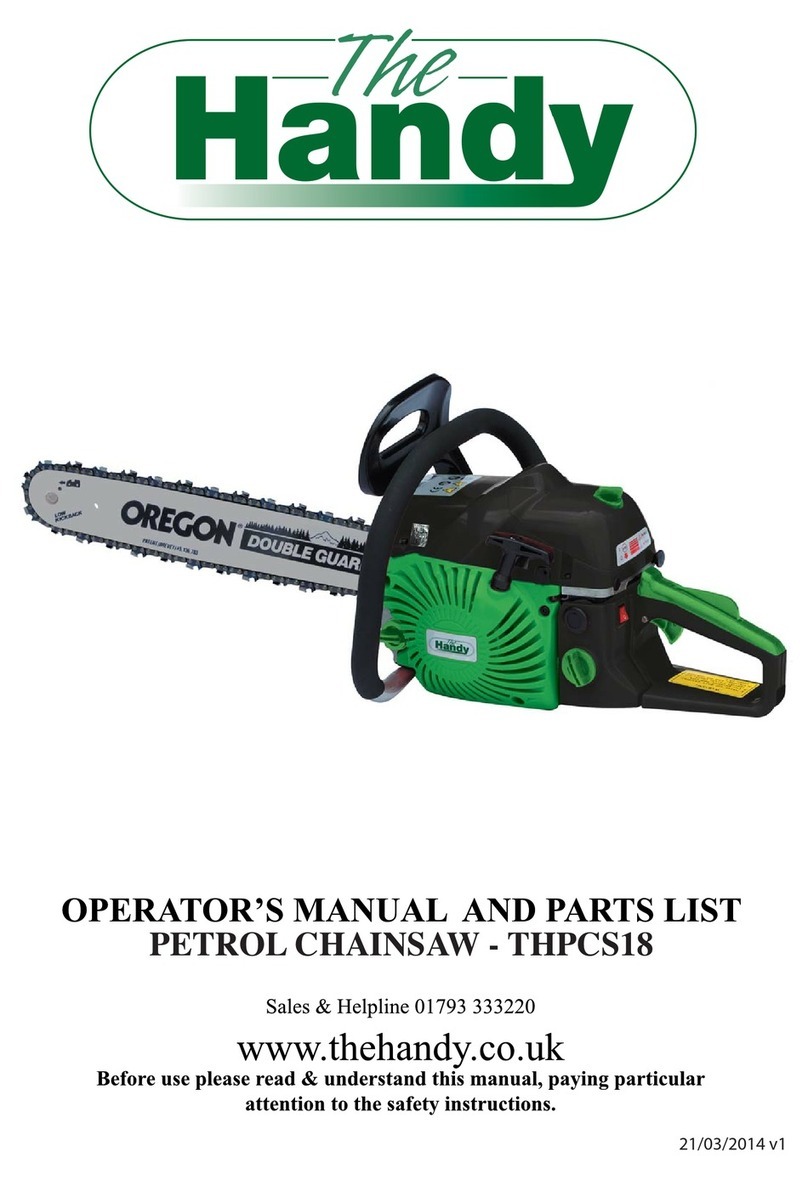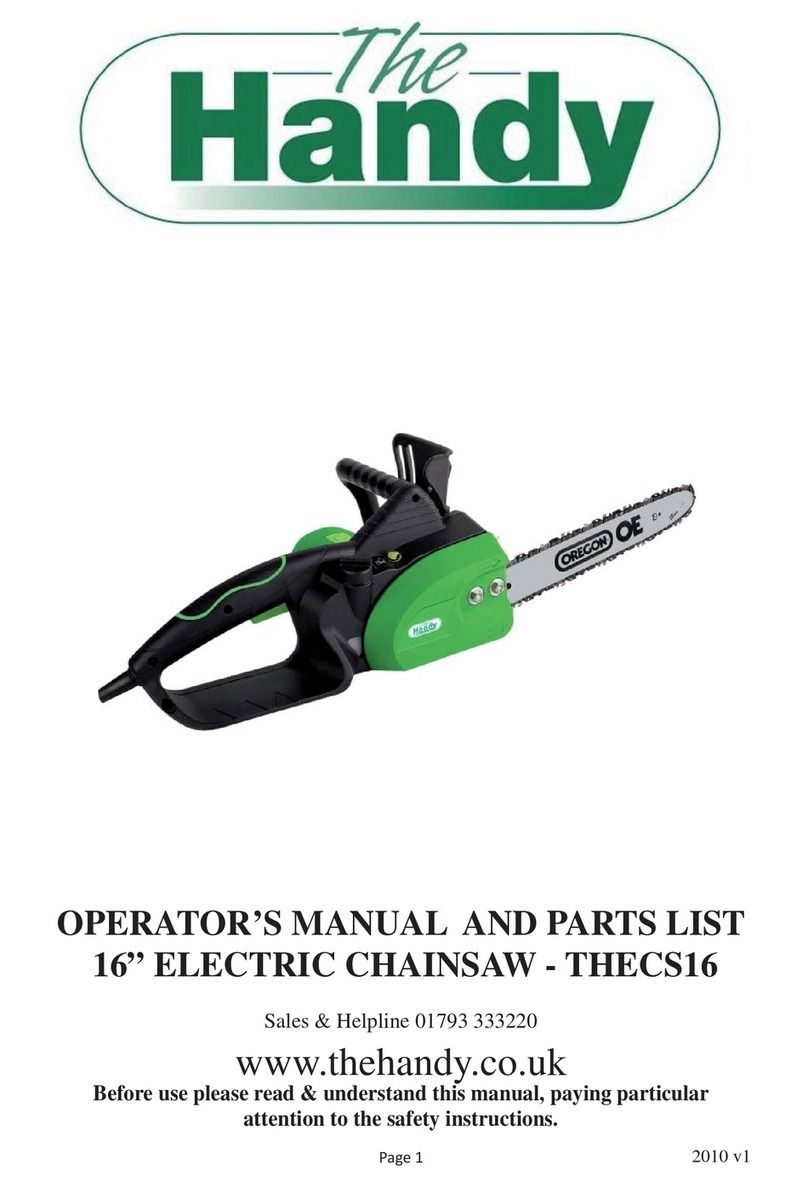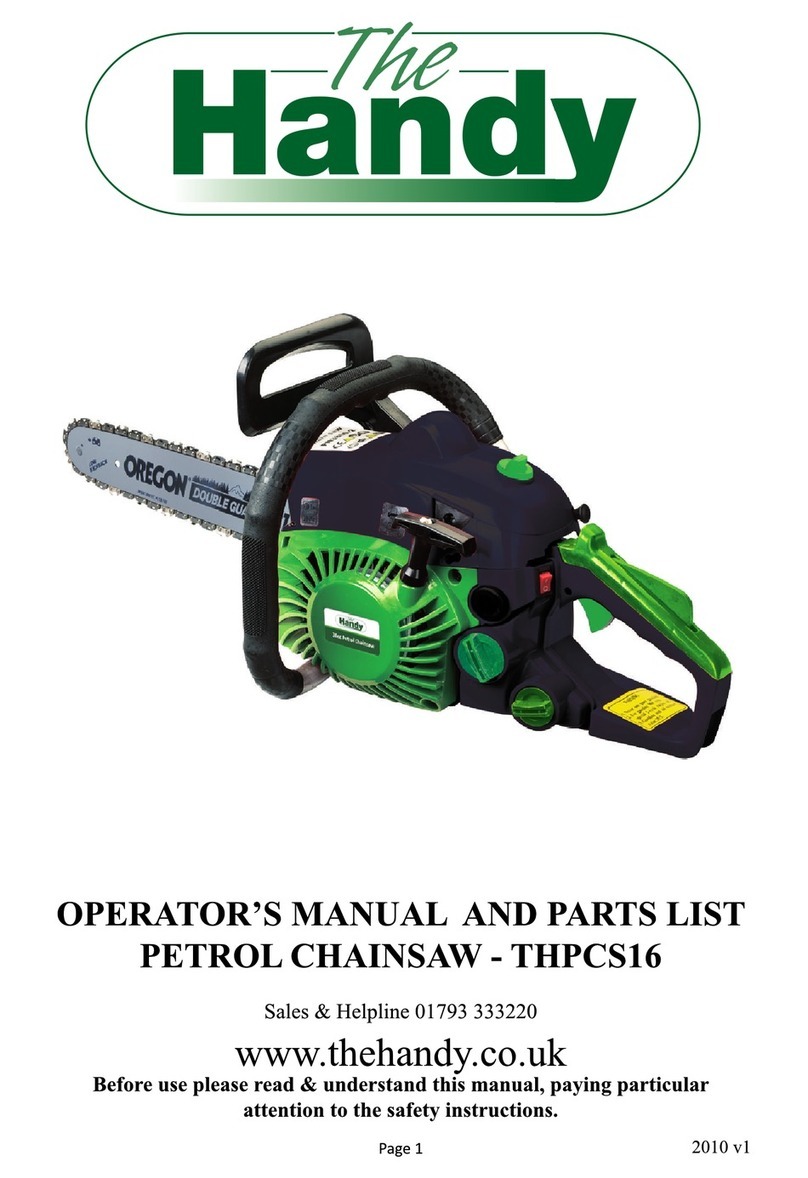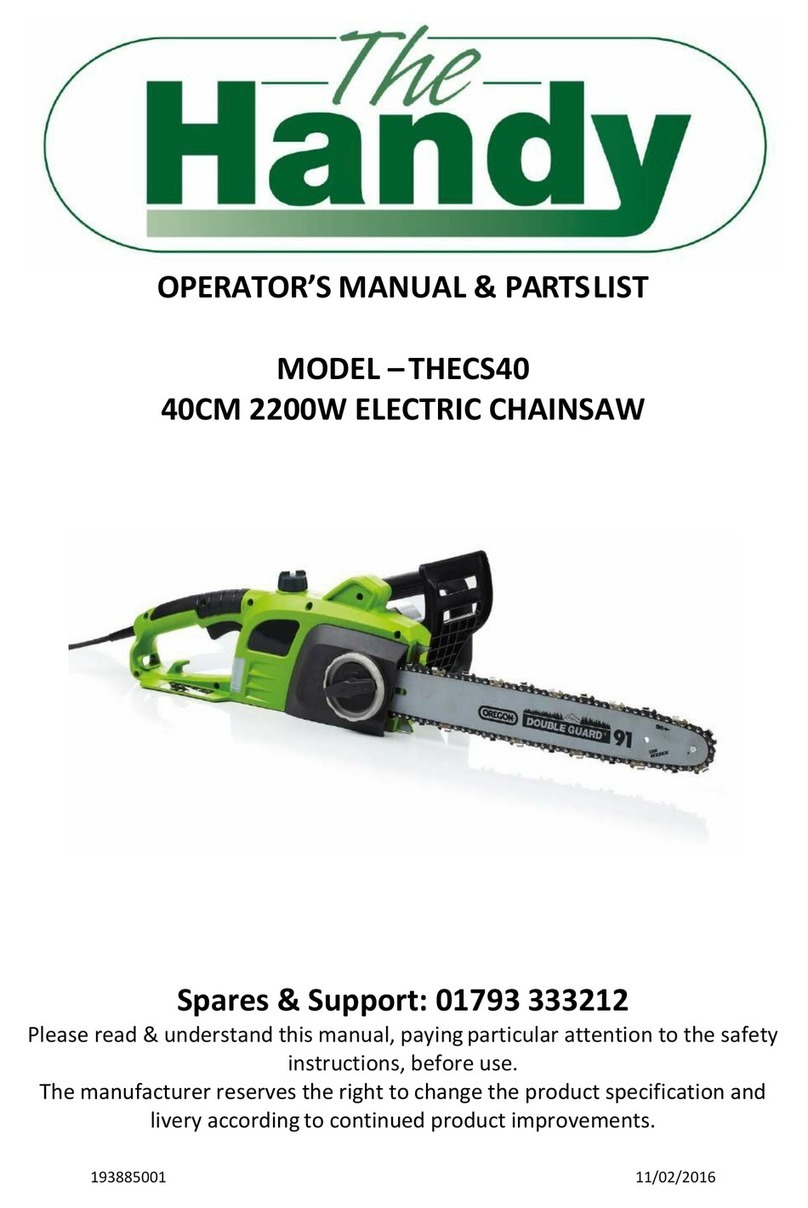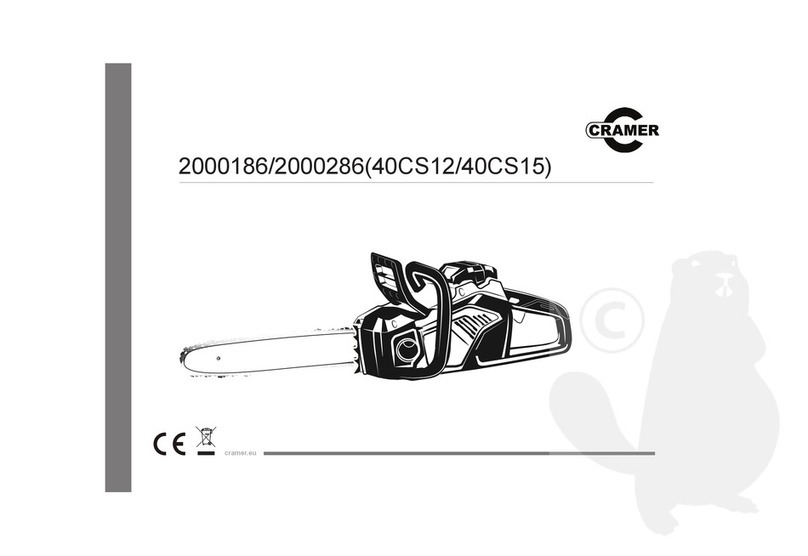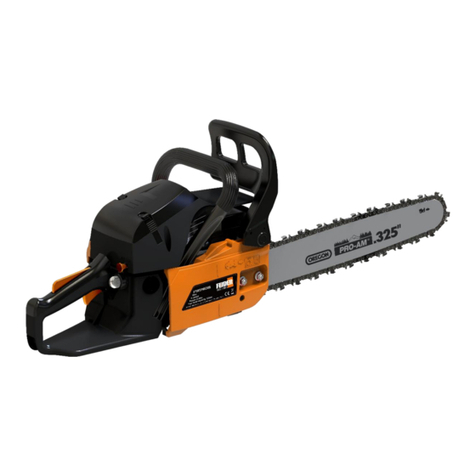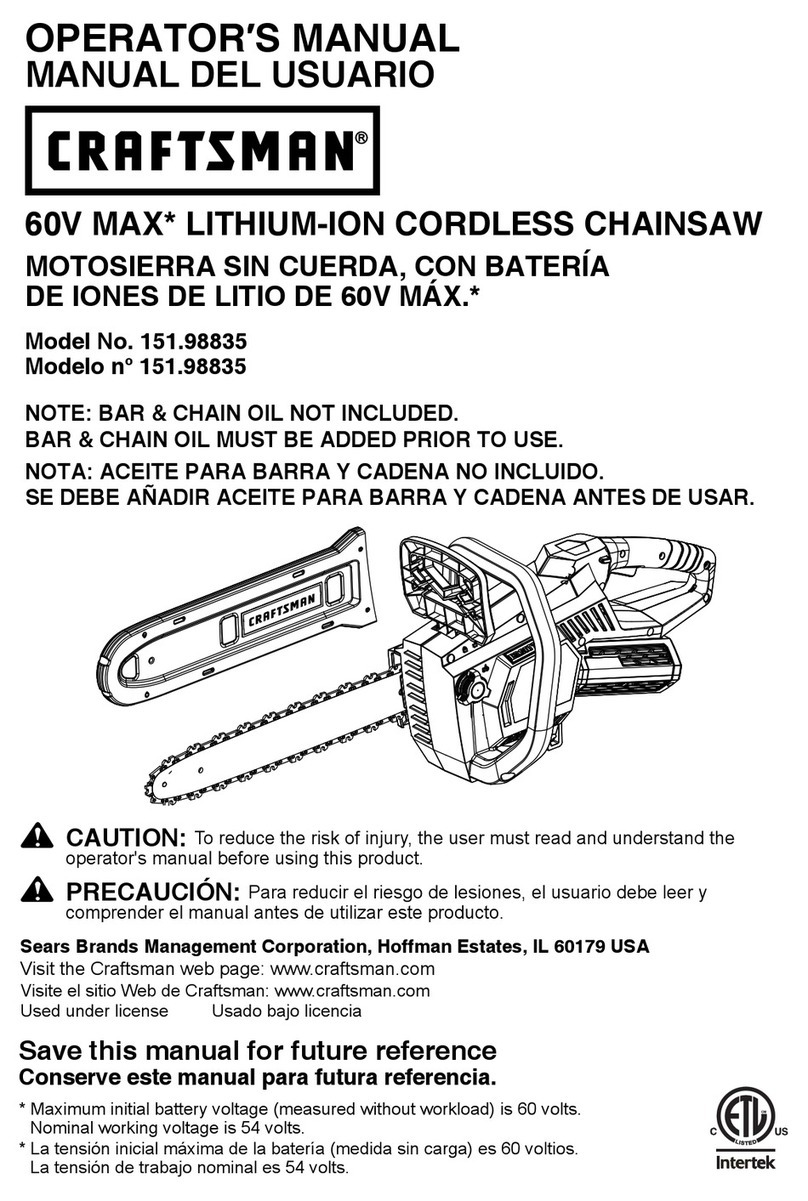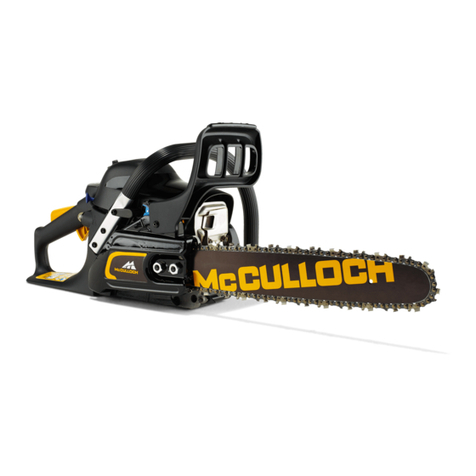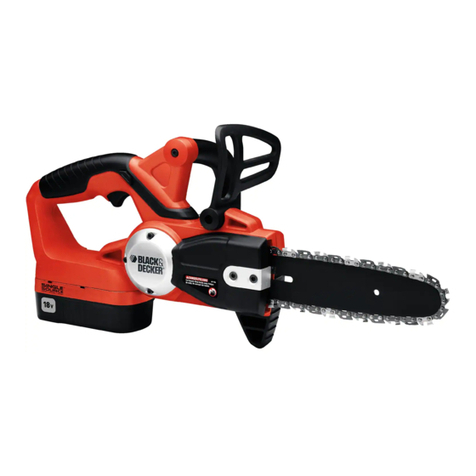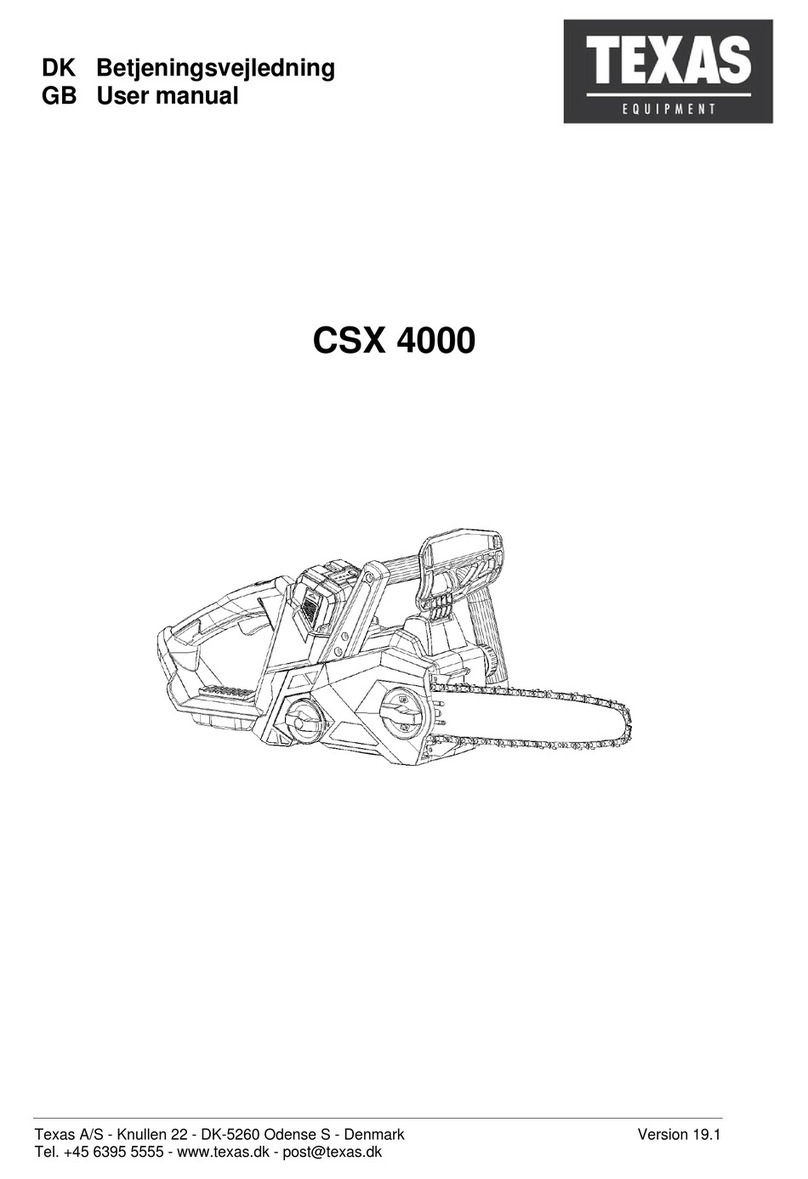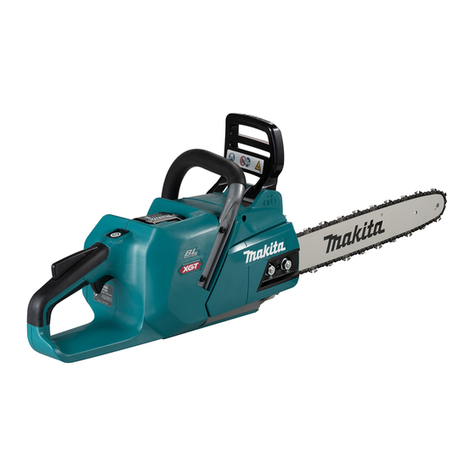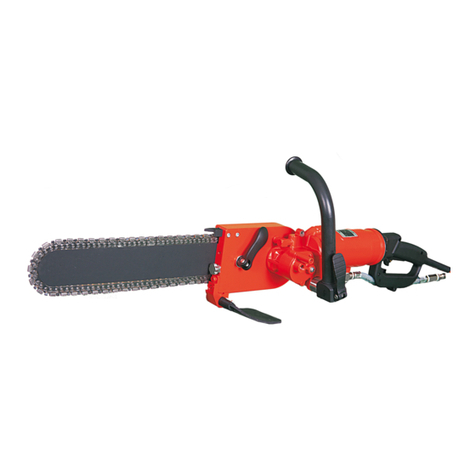The Handy THECS40 User manual

40cm 2200W
ELECTRIC CHAINSAW
MODEL NO: THECS40 -- PRODUCT NO: 193885002
EN - ORIGINAL INSTRUCTIONS
ASSEMBLY REQUIRED
SAVE THESE INSTRUCTIONS
SPARES & SUPPORT: 01793 333212
FOR YOUR SAFETY
Please read & understand this manual, paying attention to the safety instructions, before use.
Incorrect use of the product could put the operator or machine in danger.
Whilst every effort has been made to ensure the accuracy of information contained in this manual, our policy
of continuous improvement determines the right to make modifications without prior warning.
Images used are for illustration purposes only
INSTRUCTION MANUAL

Copyright Notice
Copyright © Handy Distribution
Permission is granted to reproduce this publication for personal & educational use only.
Commercial copying, redistribution, hiring or lending is prohibited.
No part of this publication may be stored in a retrieval system or transmitted in any other form or means without written
permission from Handy Distribution.
In all cases this copyright notice must remain intact.

CONTENTS
SPECIFICATIONS
IMPORTANT INFORMATION
GENERAL SAFETY INSTRUCTIONS
ELECTRICAL CONNECTION
ASSEMBLY
OPERATION
MAINTENANCE & STORAGE
TROUBLE SHOOTING
DECLARATION OF CONFORMITY
PARTS DIAGRAM & LIST
WARRANTY
ASSEMBLY IS REQUIRED
This product requires assembly before use. See the “Assembly” section for instructions.
Please check that all parts required for the assembly of this product are included. If for any reason you believe
a part for the assembly is missing or damaged, please contact us.
If you require any assistance with regards to the contents or operation of your machine,
please contact us:
TEL: 01793 333212
EMAIL: customerservice@handydistribution.co.uk
(MON –FRI 8.00AM TO 5.30PM EXCL. BANK HOLIDAYS)
SPECIFICATIONS
The manufacturer reserves the right to change the product specification and livery according to continued
product improvements.
Model
THECS40
Product Number
193885002
Motor Power
2200 watt
Motor Voltage
230-240V/50HZ
Chain Speed
13.5m/s
Guide Bar Length
406mm
Chain Pitch
3/8”
Chain Drive Links
57
Chain Gauge
0.050”
Oil Tank Capacity
240ml
Cable Length
3m
Declared Vibration Emission
4.5m/s², K=1.5m/s²
Noise Emission Value
LWA:104 dB(A) –KPA: 3 dB(A)
Protection
IP20 –CLASS II

IMPORTANT INFORMATION
INTENDED USE
This chain saw is only designed for cutting of brushes, trunks or timber beams up to a diameter according the guide
bar length. It is only allowed to cut wood. Every other use of the machine is a not intended use. Furthermore, a
professional use for tree services is strictly forbidden.
During the use of the chain saw the user has to arrange for personal protective equipment according to the manual
and also to the named pictograms on the chainsaw. Parts of the intended use are also the details in the manual
regarding safety warnings and references for use / maintenance. People/ User who work with the chainsaw or make
maintenances on it must be familiar with the manual. It is only allowed to assemble on the chain saw the
manufacturers original or approved spare parts (guide bar; saw chain, spark plug e.g.) as well as the allowed
combinations of guide bar / saw chain as named in the manual.
The user and not the manufacturer is liable for every accident which results from a combination of not intended use
or a not allowed change of the construction on the machine.
The chain saw is only intended to use outdoor.
RISIDUAL RISKS
Even with the intended use of the appliance there is always a residual risk, which cannot be prevented. According to
the type and construction of the appliance the following potential hazards might apply:
- Contact with exposed saw teeth of the saw chain (cutting hazards)
- Access to the rotating saw chain (cutting hazards)
- Unforeseen, abrupt movement of the guide bar (cutting hazards)
- Flung out of parts from the saw chain (Cutting / injection hazards)
- Flung out of parts of the work piece
- Inhalation of wood particles,
- Skin contact with chain oil,
- Loss of hearing, if required ear protection not used during work.
ELECTRICAL REQUIREMENTS
Connect the main leads to a standard 220-240V±10% (50Hz±1Hz) electrical supply which has protection devices of
under-voltage, over-voltage, over-current as well as a residual current device (RCD) which maximum residual current
rated at 0.03A.
EXTENSIONS LEADS
Improper use of extension cords may cause inefficient operation of the machine which can result in overheating. Be
sure the extension cord is no longer than 10m and its section is no less than 2.5mm² to allow sufficient current flow to
the motor. Avoid use of free and inadequately insulated connections. Connections must be made with protected
material suitable for outdoor use.
INSPECT YOUR LOG
Make sure there are no nails or foreign objects in logs to be split.

GENERAL SAFETY INSTRUCTIONS
It is important that you read and understand the owner’s manual and labels affixed to the machine. Learn its
application and limitations as well as the specific potential hazards. Retain these instructions for future
reference. The operator is responsible for following the warnings & instructions in this manual and on the
product.
Read & understand operator’s manual
before using the machine. Failure to follow
instructions could result in death or serious
injury.
Before making adjustments,
changing parts, cleaning, or
working on the log splitter, always
disconnect the power. Consult the
technical manual before servicing.
Wear protective gloves to protect your
hands
Do not smoke which using this
machine
Whenever the machine is in use, safety
glasses/goggles must be worn to safeguard
against flying objects. Hearing protection
must also be used to protect the operators
hearing. If the operator is working in an
area where there is a risk of falling objects,
a safety helmet must also be worn.
Do not use near a flame, or sparks
Wear protective footwear
Dispose of all oil at an authorised
collection point or follow the local
stipulations that apply where the
log splitter is being used. Dispose
of used oil in an environmentally
friendly way.
Check your machine before turning it on.
Keep guards in place and in working order.
Replace damaged, missing or failed parts
before using it.
Keep all bystanders & animals at
least 15 metres away from the
machine during operation.
If approached, stop the machine
immediately.
Do not use in the rain.
Double insulated or class 2
electrical appliances are products
that have been designed in a way
so as not to require a safety
connection to electrical earth
(These products must NOT have a
safety connection to Earth).
The chainsaw is supplied with a KICKBACK
chain, however sometimes kick back can
occur, so always hold the unit firmly in two
hands. The Kickback danger zone on your
chainsaw is the upper part of the nose of
the guide bar. Never saw using this part of
the guide bar, which poses a significant risk
for kickback.
Correct direction of cutting teeth
Safety alert symbol. Used to alert you to
potential personal injury hazards. Obey all
safety messages that follow this symbol to
avoid possible injury.
DANGER
Indicates an imminently hazardous
situation which, if not avoided, will
result in serious injury.
WARNING
Indicates a potentially hazardous situation
which, if not avoided, could result in
serious injury
CAUTION
Indicates a potentially hazardous
situation which, if not avoided,
may result in minor or moderate
injury.
CAUTION
Used without the safety alert symbol
indicates a potentially hazardous situation
which, if not avoided, may result in
property damage.
This symbol on the product or on
its packaging indicates that this
product may not be treated as
household waste. Instead it shall
be handed over to the applicable
collection point for the recycling of
electrical and electronic
equipment. For more detailed
information about recycling of this
product, please contact your local
council office, your household
waste disposal service or shop
where you purchased the product.

WARNING
Read all safety warnings and all instructions. Failure to follow the warnings and instructions may result in
electric shock, fire and/or serious injury.
Save all warnings and instructions for future reference. The term "power tool" in the warnings refers to your
mains-operated (corded) power tool or battery-operated (cordless) power tool.
WORK AREA SAFETY
Keep work area clean and well lit. Cluttered or dark areas invite accidents.
Do not operate power tools in explosive atmospheres, such as in the presence of flammable liquids, gases or
dust. Power tools create sparks which may ignite the dust or fumes.
Keep children and bystanders away while operating a power tool. Distractions can cause you to lose control.
ELECTRICAL SAFETY
Power tool plugs must match the outlet. Never modify the plug in any way. Do not use any adapter plugs with
earthed (grounded) power tools. Unmodified plugs and matching outlets will reduce risk of electric shock.
Avoid body contact with earthed or grounded surfaces, such as pipes, radiators, ranges and refrigerators.
There is an increased risk of electric shock if your body is earthed or grounded.
Do not expose power tools to rain or wet conditions. Water entering a power tool will increase the risk of
electric shock.
Do not abuse the cord. Never use the cord for carrying, pulling or unplugging the power tool. Keep cord away
from heat, oil, sharp edges or moving parts. Damaged or entangled cords increase the risk of electric shock.
When operating a power tool outdoors, use an extension cord suitable for outdoor use. Use of a cord suitable
for outdoor use reduces the risk of electric shock.
If operating a power tool in a damp location is unavoidable, use a residual current device (RCD) protected
supply. Use of an RCD reduces the risk of electric shock.
PERSONAL SAFETY
Stay alert, watch what you are doing and use common sense when operating a power tool. Do not use a power
tool while you are tired or under the influence of drugs, alcohol or medication. A moment of inattention while
operating power tools may result in serious personal injury.
Use personal protective equipment. Always wear eye protection. Protective equipment such as dust mask,
non-skid safety shoes, hard hat, or hearing protection used for appropriate conditions will reduce personal
injuries.
Prevent unintentional starting. Ensure the switch is in the off-position before connecting to power source
and/or battery pack, picking up or carrying the tool. Carrying power tools with your finger on the switch or
energising power tools that have the switch on invites accidents.
Remove any adjusting key or wrench before turning the power tool on. A wrench or a key left attached to a
rotating part of the power tool may result in personal injury.
Do not overreach. Keep proper footing and balance at all times. This enables better control of the power tool
in unexpected situations.
Dress properly. Do not wear loose clothing or jewellery. Keep your hair, clothing and gloves away from moving
parts. Loose clothes, jewellery or long hair can be caught in moving parts.
If devices are provided for the connection of dust extraction and collection facilities, ensure these are
connected and properly used.
POWER TOOL USE AND CARE
Do not force the power tool. Use the correct power tool for your application. The correct power tool will do
the job better and safer at the rate for which it was designed.
Do not use the power tool if the switch does not turn it on and off. Any power tool that cannot be controlled
with the switch is dangerous and must be repaired.
Disconnect the plug from the power source and/or the battery pack from the power tool before making any
adjustments, changing accessories, or storing power tools. Such preventive safety measures reduce the risk of
starting the power tool accidentally.
Store idle power tools out of the reach of children and do not allow persons unfamiliar with the power tool or
these instructions to operate the power tool. Power tools are dangerous in the hands of untrained users.
Maintain power tools. Check for misalignment or binding of moving parts, breakage of parts and any other
condition that may affect the power tool’s operation. If damaged, have the power tool repaired before use.
Many accidents are caused by poorly maintained power tools.
Keep cutting tools sharp and clean. Properly maintained cutting tools with sharp cutting edges are less likely to

bind and are easier to control.
Use the power tool, accessories and tool bits etc. in accordance with these instructions, taking into account the
working conditions and the work to be performed. Use of the power tool for operations different from those
intended could result in a hazardous situation.
ADDITIONAL SAFETY POINTS FOR YOUR ELECTRIC CHAINSAW
Keep all parts of the body away from the saw chain when the chain saw is operating. Before you start the chain
saw, make sure the saw chain is not contacting anything. A moment of inattention while operating chain saws
may cause entanglement of your clothing or body with the saw chain.
Always hold the chain saw with your right hand on the rear handle and your left hand on the front handle.
Holding the chain saw with a reversed hand configuration increases the risk of personal injury and should
never be done.
Wear safety glasses and hearing protection. Further protective equipment for head, hands, legs and feet is
recommended. Adequate protective clothing will reduce personal injury by flying debris or accidental contact
with the saw chain.
Do not operate a chain saw in a tree. Operation of a chain saw while up in a tree may result in personal injury.
Always keep proper footing and operate the chain saw only when standing on fixed, secure and level surface.
Slippery or unstable surfaces such as ladders may cause a loss of balance or control of the chain saw.
When cutting a limb that is under tension be alert for spring back. When the tension in the wood fibre is
released the spring-loaded limb may strike the operator and/or throw the chain saw out of control.
Use extreme caution when cutting brush and saplings. The slender material may catch the saw chain and be
whipped toward you or pull you off balance.
Carry the chain saw by the front handle with the chain saw switched off and away from your body. When
transporting or storing the chain saw always fit the guide bar cover. Proper handling of the chain saw will
reduce the likelihood of accidental contact with the moving saw chain.
Follow instructions for lubricating, chain tensioning and changing accessories. Improperly tensioned or
lubricated chain may either break or increase the chance for kickback.
Keep handles dry, clean, and free from oil and grease. Greasy, oily handles are slippery causing loss of control.
Cut wood only. Do not use chain saw for purposes not intended. For example: do not use chain saw for cutting
plastic, masonry or non-wood building materials. Use of the chain saw for operations different than intended
could result in a hazardous situation.
Using of a residual cutting device with a tripping current of 30 mA or less is recommended.
Hold the power tool by insulated gripping surfaces only, because the saw chain may contact hidden wiring or
its own cord. Saw chains contacting a "live" wire may make exposed metal parts of the power tool "live" and
could give the operator an electric shock
CAUSES AND OPERATOR PREVENTION OF KICKBACK:
Kickback may occur when the nose or tip of the guide bar touches an object, or when the wood closes in and
pinches the saw chain in the cut.
Tip contact in some cases may cause a sudden reverse reaction, kicking the guide bar up and back towards the
operator.
Pinching the saw chain along the top of the guide bar may push the guide bar rapidly back towards the
operator.
Either of these reactions may cause you to lose control of the saw which could result in serious personal injury.
Do not rely exclusively upon the safety devices built into your saw. As a chain saw user, you should take several
steps to keep your cutting jobs free from accident or injury.
Kickback is the result of tool misuse and/or incorrect operating procedures or conditions and can be avoided
by taking proper precautions as given below:
•Maintain a firm grip, with thumbs and fingers encircling the chain saw handles, with both hands on
the saw and position your body and arm to allow you to resist kickback forces. Kickback forces can be
controlled by the operator, if proper precautions are taken. Do not let go of the chain saw.
•Do not overreach and do not cut above shoulder height. This helps prevent unintended tip contact
and enables better control of the chain saw in unexpected situations.
•Only use replacement bars and chains specified by the manufacturer. Incorrect replacement bars and
chains may cause chain breakage and/or kickback.
•Follow the manufacturer’s sharpening and maintenance instructions for the saw chain. Decreasing the
depth gauge height can lead to increased kickback.

MAINTAIN YOUR MACHINE WITH CARE
Clean the machine immediately after use. Keep the machine clean to ensure it operates to its full and safest
performance. When maintaining this machine, only the manufacturer’s original replacement parts should be
used. The use of non-original manufacturer parts may invalidate your warranty.
PROTECT THE ENVIRONMENT
Take left over materials to an authorised collection point or follow the stipulations in the country where the
machine is used. Do not discharge into drains, soil or water.
STORE IDLE EQUIPMENT
When not in use, the machine should be stored in a dry location. Keep the machine away from children and
others not qualified to use it.
ONLY USE APPROVED REPLACEMENT PARTS
Only use approved replacement parts. Unauthorised replacement parts can cause damage to the machine and
invalidate your warranty.
RESIDUAL RISK
Even with the intended use of the appliance there is always a residual risk, which cannot be prevented.
ELECTRICAL CONNECTION
Do not connect either core to the earth pin
The insulation on the grounded three metre electrical cord willonly remain effectiveif the original insulating
parts are used for repairs and the spaces between the original insulation are maintained.
The use of a Residual Current Device (“RCD”), on 230V electrics is recommended. If using an extension cable,
plug it directly into the RCD

ASSEMBLY
Remove the machine and contents from the carton. Be sure the carton is empty before discarding.
If you require any assistance with regards to the contents of the product, please contact us:
Tel: 01793 333212 - Mon –Fri 8.00am –5.30pm (excl. Bank Holidays)
WARNING
Do not connect the chainsaw to the mains before it is assembled completely.
Always use gloves when handling the chain.
1. Rear Handle
2. Throttle Trigger
3. Lock Button
4. Oil Cap
5. Front Handle
6. Chain Brake
7. Guide Bar
8. Chain
9. Spike
10. Blade Guard
11. Locking Knob & Chain Tensioner
12. Side Cover
13. Drive Sprocket
14. Guide
15. Cutting Direction Symbol
16. Oil Lever Gauge
13
14
15
16

CHAIN & BAR ASSEMBLY
1. Place the chainsaw on a flat, solid surface.
2. Slide the chain in the groove of the guide bar.
3. Ensure the chain is in the correct running direction.
4. Ensure the chain tensioning catch on the guide bar is facing outwards.
5. Fit the chain onto the drive sprocket and guide bar, so the fastening bolt and two guide fins fit into the
keyway of the guide bar.
6. Ensure all parts are seated correctly & hold the chain and guide bar in a level position.
7. Pull the guide bar away from the machine, ensuring the chain is tight and positioned in the guide bar
groove.
8. Fit the cover plate; ensure the chain catcher fits into the groove of the cover plate.
9. Press the cover plate firmly onto the machine and screw on the cover plate, with the locking knob.
CAUTION
The chain is not yet tensioned; do not attempt to use the machine, until the assembly instructions are
completed thoroughly.
CHAIN TENSION
Always check the chain tension before use, after the first cuts and regularly during use, approx. every 10
minutes. Upon initial operation, new chains can lengthen considerably.
WARNING
Unplug the chainsaw from the power source before adjusting the chain tension
WARNING
Cutting edges on the chain are extremely sharp. Always use protective gloves when handling the chain.
WARNING
Always maintain proper chain tension. A loose chain will increase the risk of kickback. A loose chain may
jump out of the guide bar groove, which may injure the operator and damage the chain, chain bar and drive
sprocket, beyond repair.
CAUTION
The life of a saw chain will rely on sufficient lubrication and correct tensioning.
Avoid tensioning the chain if it is hot. This will cause the chain to be over tensioned, when it cools down.
CHAIN DIRECTION
CHAIN TENSIONING CATCH

1. Place the chainsaw on a flat, solid surface.
2. Rotate the locking knob/chain tensioning knob clockwise, until the locking knob is screwed tightly. The
correct chain tension will be reached automatically. The ratchet mechanism prevents the chain tension
from loosening.
3. The correct chain tension is reached when the chain can be raised 3-6mm from the centre of the chain
bar. This should be done, by using one hand to raise the chain against the weight of the machine.
4. If the chain loses tension, unscrew the locking knob/chain tensioning knob completely. Then screw on the
cover plate with the locking knob tightly again.
LUBRICATION
Chain life and cutting capacity depend on optimum lubrication. Therefore, the chain is automatically oiled
during operation via the oil outlet.
CAUTION
The Chainsaw IS NOT supplied filled with chain oil. It is essential to fill the oil canister with chain oil before
use. Never operate the chainsaw without chain oil or at an empty oil tank level, as this will result in
extensive damage to the product, not covered by the manufacturer’s warranty.
FILLING THE OIL TANK
1. Place the chainsaw on a flat, solid surface with the oil filler cap facing upwards.
2. Clean the area around the oil filler cap with a suitable cloth.
3. Unscrew the oil filler cap.
4. Add chainsaw oil, until the reservoir is full.
5. Avoid dirt or debris from entering the oil tank.
6. Refit the oil filler cap and tighten sufficiently.
CAUTION
To allow venting of the oil reservoir, small breather channels are provided between the oil filler cap and the
strainer. To prevent leakage, ensure the machine is left in a horizontal position (oil filler cap uppermost)
when not in use. It is important you only use recommended oil to avoid damage to the chainsaw.
Never use recycled or old chain oil. Use of non-approved oil will invalidate the manufacturer’s warranty.
OPERATION
STARTING THE MACHINE
1. Using your right hand, press the safety button (3) with your thumb.
2. Then fully press the throttle trigger (2) with your index finger.
3. The safety button (3) can now be released.
STOPPING THE MACHINE
1. To stop the machine, release the throttle trigger.
2. Do not stop the chainsaw, by activating the front hand guard (chain brake).

CHAIN BRAKE
The chain brake is a safety mechanism activated through the front hand guard, when kickback occurs. The
chain stops immediately.
The following function check should be carried out at regular intervals.
1. Push the front hand guard forwards and start the chainsaw.
2. The chain MUST NOT rotate.
3. To deactivate the kickback brake, pull the hand guard backwards and release the throttle trigger.
CUTTING
PRIOR TO CUTTING, IS THE OIL RESERVOIR FILLED?
Check the oil level gauge prior to starting & regularly during operation.
Refill the oil tank when the level is low.
A full oil tank, will last approximately 16 minutes, depending on sawing intensity and stops.
IS THE CHAIN LUBRICATED SUFFICIENTLY?
A correct operation of the automatic oiler can be checked by running the chainsaw and pointing the tip of the
chain bar, towards a piece of cardboard or paper positioned on the ground
CAUTION: Do not touch the ground with the chain. Ensure safety clearance of 20cm.
If an increasing oil pattern appears, the automatic oiler is operating correctly.
If there is no oil pattern, despite a full oil reservoir, see the Troubleshooting section of this manual.
IS THE CHAIN TENSION IN ORDER AND THE CHAIN SHARP?
Check a new chain’s tension, every 10 minutes during initial operation. During the first uses, a new chain can
lengthen considerably.
The condition of the chain influences the cutting performance of the machine.
Only a sharp chain protects the chainsaw from overload.
ARE YOU WEARING THE SUITABLE & NECESSARY PROTECTIVE EQUIPMENT?
Whenever the machine is in use, safety glasses/goggles must be worn to safeguard against flying objects.
Hearing protection must also be used to protect the operators hearing.
If the operator is working in an area where there is a risk of falling objects, a safety helmet must also be worn.
Wear boots with saw protection, steel-toe cap and non- slip sole.
Suitable chainsaw protection gloves are also recommended.
Adequate protective clothing will reduce personal injury from flying debris or accidental contact with the saw
chain.

KICKBACK
Kickback is the sudden backward/upward motion of the chainsaw, occurring when the chain (at the tip of the
chain bar) comes into contact with a log or wood, or when the chain becomes jammed.
When Kickback occurs, the chainsaw reacts unpredictably and can cause severe injuries to the operator or
bystanders.
To avoid Kickback:
-Saw with the guide bar at a flat angle
-Never work with a loose, widely stretched or heavily worn out chain.
-Ensure the chain is sharpened correctly.
-Never saw above shoulder height.
-Never work with the tip of the guide bar.
-Always hold the chainsaw firmly with two hands.
-Always use a low kickback chain.
-Apply the metal spike for leverage.
-Ensure correct chain tension.
GENERAL BEHAVIOUR
Always hold the chainsaw firmly with both hands. Front grip with the left hand and the rear grip with the right
hand.
Ensure the electrical power cord is located to the rear, away from the chain and the wood being cut,
positioned so that it cannot be caught on branches or the like during cutting.
Use the chainsaw only with secure footing.
Hold the chainsaw on the right-side of your body, during use.
The chain must be running at full speed before it makes contact with the wood.
Use the metal spike on the front of the chainsaw, to secure the machine onto the wood before starting to cut.

Reset the gripping spike at a low point when sawing thicker logs, by pulling the chainsaw, slightly backwards,
until the gripping spike release and reposition at a lower level to continue sawing. Do not remove the chainsaw
completely from the wood.
Do not force the chain whilst cutting, let the chain do the work, using the gripping spike to apply minimal
leverage pressure.
Do not operate the chainsaw with arms fully extended or attempt to saw areas which are difficult to reach, or
on a ladder. Never use the chainsaw above shoulder height.
Sawing is optimized when the chain speed remains steady during cutting. Beware when reaching the end of
the cut. The weight of the saw may change unexpectedly, as it cuts free from the wood. Accidents can occur to
the legs and feet. Always remove the saw from a wood cut while the saw is running.
CUTTING LOGS
Observe the following safety instructions:
Support the log being cut, to prevent face sides from closing in against each other, which would result in the
chain being jammed or pinched.
Position and set short logs safely prior to sawing. Saw only wood or wooden objects.
When sawing, always take care to avoid hitting stones, nails etc, as these could be thrown up, cause damage to
the chain or serious injury to the operator or bystanders.
Keep a running saw clear of wire fencing or the ground.
Use of the saw to thin out branches or bushes is not approved. Length cuts must be carried out with care, as
leverage with the gripping spike is not possible. Saw at a flat angle to avoid kickback.
When working on a slope, operate above or to the side of the trunk or laying tree.
Be careful not to trip over tree stumps, branches, roots, etc.
CUTTING WOOD UNDER TENSION
There is a high risk of accidents when sawing wood, branches or trees under tension. Be extremely careful.
Leave saw jobs like these to professionals.
When sawing logs supported on both ends, start the cut from above (Y) about 1/3 of the diameter into the log
and then finish the cut (Z) from below, in order to avoid contact of the chainsaw with the ground. When
sawing logs supported on only one end, start the cut from below (Y) about 1/3 of the diameter into the log and
finish the cut from above (Z) in order to avoid splitting or jamming of the chainsaw.

FELLING TREES
Always wear a hard hat to protect your head against falling branches.
The chainsaw can only be used to fell trees smaller in diameter than the length of the guide bar.
1. Secure work area. Ensure no persons or animals are in the vicinity of the falling tree. Never attempt to
free a jammed saw with the motor running. Use wooden wedges to free the chain and guide bar. When
cutting and felling operations are being performed by two or more persons, at the same time, the felling
operations should be separated from the cutting operation by a distance of at least twice the height of the
tree being felled. Trees should not be felled in a manner that would endanger any person, strike any utility
line or cause any property damage. If the tree does make contact with any utility line, the relevant utility
owner/company should be notified immediately. The chainsaw operator should keep on the uphill side of
the terrain as the tree is likely to roll or slide downhill after it is felled.
2. An escape path should be planned and cleared as necessary before cuts are started. The escape path
should extend back and diagonally to the rear of the expected line of fall.
3. Before felling is started, consider the natural lean of the tree, the location of larger branches and the wind
direction to judge which way the tree will fall. Remove dirt, stones, loose bark, nails staples, and wire from
the tree.
Notching undercut: Make the notch (X-W) 1/3 the diameter of the tree, perpendicular to the direction of falls
as make the lower horizontal notching cut first. This will help to avoid pinching either the saw chain or the
guide bar when the second notch is being made.
Felling back cut: Make the felling back cut (Y) at least 50 mm higher than the horizontal notching cut. Keep the
felling back cut parallel to the horizontal notching cut. Make the felling back cut so enough wood is left to act
as a hinge. The hinge wood keeps the tree from twisting and falling in the wrong direction. Do not cut through
the hinge. As the felling gets close to the hinge the tree should begin to fall. If there is any chance that the tree
may not fall in desired direction or it may rock back and bind the saw chain, stop cutting before the felling back
cut is complete and use wedges of wood, plastic, or aluminum to open the cut and drop the tree along the
desired line of fall. When the tree begins to fall remove the chain saw from the cutting, stop the motor, put
the chain saw down, and then use the retreat path planned. Be alert for overhead limbs falling and watch your
footing. To complete the felling operation, drive a wedge (Z) into the horizontal cut. Beware of falling branches
when the tree starts to move.
LIMBING A TREE
Limbing is removing the branches from a fallen tree. When limbing, use larger lower limbs to support the log
off the ground. Remove the small limbs in one cut as illustrated. Branches under tension should be cut from
the bottom up to avoid binding the chainsaw.
BUCKING A LOG
Bucking is cutting a log into lengths. It is important to make sure your footing is firm, and your weight is evenly
distributed on both feet. When possible, the log should be raised and supported by the use of limbs, logs or
chocks. Follow the simple directions for easy cutting.
When the log is supported along its entire length as illustrated, it is cut from the top (overbuck).

When the log is supported on one end, as illustrated below, cut 1/3 the diameter from the underside
(underbuck). Then make the finished cut by over bucking to meet the first cut.
When the log is supported on both ends, as illustrated, cut 1/3 the diameter from the top overbuck. Then
make the finished cut by under bucking the lower 2/3 to meet the first cut.
When bucking on a slope always stand on the uphill side of the log, as illustrated. When “cutting through”, to
maintain complete control, release the cutting pressure near the end of the cut without relaxing your grip on
the chainsaw handles. Don’t let the chain contact the ground. After completing the cut, wait for the saw chain
to stop, before you move the chainsaw. Always stop the motor before moving from tree to tree
MAINTENANCE & STORAGE
WARNING
Before any maintenance or cleaning operation is undertaken, ensure the mains plug is removed from the
wall socket.
Improper maintenance & storage of the machine may void your warranty.
Keep the machine clean for better and safer performance.
MAINTENANCE
•Before each use, check all nuts & bolts to be sure they are sufficiently tightened.
•Regularly check for obvious defects such as loose, dislodged or damaged chain and guide bar, loose fixings
and worn or damaged components.
•Check that covers and guards are undamaged and correctly fitted. Carry out necessary maintenance or
repairs before using the chainsaw.
•Ensure the breather openings on the motor casing are open and clean from debris. If they are blocked, the
motor could overheat and shut the machine down.
•We recommend only manufacturer original parts are used when maintaining this machine. Failure to do so
could invalidate your manufacturer’s warranty.

REPLACING/CHANGING CHAIN & GUIDE BAR
Fit the chain and guide bar as described in “Assembly and Tensioning Chain”.
The circular groove of the guide bar will wear particularly on the lower edge with time. When replacing the
chain, turn the chain bar 180° to allow even wear, thus extending chain bar life.
Check the drive sprocket. If it is worn out or damaged due to strain, have it exchanged by an authorised service
dealer.
If the chain bar is worn out or damaged, take the chain tensioning catch off the bar by losing the screw anti-
clockwise. Then fit the tensioning catch onto the new bar by tightening the screw clockwise. The catch
protrudes (a) must be fitted into the bar hole.
CHAIN SHARPENING
Have your chain professionally sharpened at your local approved service dealer. Alternatively, sharpen the
chain yourself using a 3/8” Chainsaw file & guide (We recommend Handy Part HP-106).
CAUTION
Any maintenance and repairs carried out, to any electronic component must be undertaken by a qualified
technician.
CLEANING
•Keep your machine clean.
•Clean the molded plastic housing of the chainsaw using a soft brush and clean cloth.
•Do not use water, solvents or polishes. Remove all debris, especially from the motor cooling vents.
•Remove and brush clean the cover plate, chain and chain bar after 1 to 3 hours of use.
•Clean the area under the cover plate, the drive sprocket and chain bar assembly using a soft brush.
•Clean the oil outlet with a clean cloth.
•If the chainsaw is to be stored for a longer period of time, clean the chain and chain bar.
•Store in a secure, dry place out of the reach of children.
•Do not place other objects on the chain saw.
•To prevent leakage, ensure the machine is left in a horizontal position (oil filler cap uppermost).
•When storing the machine in the original packaging, the oil tank must be completely emptied.
CAUTION
Clean the tool after each use. Failure to carry out proper cleaning can result in damage to the appliance or
cause it to malfunction.
WARNING
Injury may occur when working on the chain. Wear protective gloves.
STORAGE
•For years of trouble free service, make sure the machine is clean and dry beforestoring.
•Before storing, clean the machine thoroughly as indicated above.
•Store indoors or in a protected area during severe weather and winter months. Always fit the blade guard.

TROUBLE SHOOTING
PROBLEM
POSSIBLE CAUSES
RESOLUTION
Chainsaw fails to
operate
1. Chain brake is activated
2. No power
3. Mains socket faulty
4. Extension cable damaged or
does not meet manufacturer
requirements
5. Fuse faulty
1. Pull chain brake back to position
2. Check power
3. Use another socket
4. Check cable & replace
5. Replace fuse
Chain saw operates
intermittently
1. Extension cord damaged
2. Loose connection
3. Internal wiring defective
4. On/Off trigger defective
1. Check cord, replace
2. Contact service agent
3. Contact service agent
4. Contact service agent
Dry chain
1. No oil in reservoir
2. Vent in oil filler cap clogged
3. Oil passage clogged
1. Refill oil
2. Clean cap
3. Clean oil passage outlet
Kickback Brake/Run
Down Brake
1. Brake does not stop chain
1. Contact service agent
Chain/chain bar
overheats
1. No oil in reservoir
2. Vent in oil filler cap clogged
3. Oil passage clogged
4. Chain is over tensioned
5. Dull chain
1. Refill oil
2. Clean cap
3. Clean oil passage outlet
4. Adjust locking knob
5. Sharpen chain or replace
Chain saw rips,
vibrates,
does not saw properly
1. Chain tension too loose
2. Dull chain
3. Chain worn out
4. Chain teeth are facing in the
wrong direction
1. Adjust locking knob
2. Sharpen chain or replace
3. Replace chain
4. Reassemble with chain in correct
5. direction
NEVER USE TOOLS WITH A DEFECTIVE ON/OFF THROTTLE TRIGGER or CHAIN BRAKE (HAND GUARD)

EC DECLARATION OF CONFORMITY
We, Importer
Handy Distribution, Murdock Road, Dorcan, Swindon, SN3 5HY
Designation: 40cm Electric 2200w Chainsaw
Model(s): THECS40
Product Number: 193885002
Type/Serial No: As per rating label on machine
Motor Wattage: 2200
Complies with the following directives:
Machinery Directive 2006/42/EC
Noise Directive 200/14/EC as amended by 2005/88/EC
Electro Magnetic Directive 2004/108/EC
RoHS Directive 2011/65/EU
Relevant Standard(s), Specification(s) referred to:
ZEK 01.4-08 PAH, EN 60745-2-13: 2009+A1:2010, EN 60745-1: 2009+A11:2010
ISO 22868:2005, EN ISO 3744:1995
EN55014-1:2006/+A1:2009/+A2:2001, EN55014-2: 1997/+A1:2001/+A2:2008
EN61000-3-3:2013, EN 61000-3-2: 2006/+A1:2009/+A2:2009
EN6100-3-11:2000
Name of the Notified Body:
Intertek Testing Services Shanghai
Building No.86, 1198 Qinzhou Road (North), Shanghai 200233, P.R China
&
TUV Rheinland (Shanghai) Co. Ltd
Shanghai Rheinland Building, No. 177, Lane 777, West Guangzhong Road, Zhabei, Shaghai 200072,
P.R China
Additional Information
Guaranteed Sound Pressure Level: LWA 108.0 dB(A)
Authorised signatory and technical fileholder
Date: 17/12/2018
Signature:
Name/Title: Simon Belcher (Mr)
Position: Chairman
Murdock Road, Dorcan, Swindon, Wiltshire, SN3 5HY.

PARTS DIAGRAM –THECS40 (193885002)
Other manuals for THECS40
1
Other The Handy Chainsaw manuals
